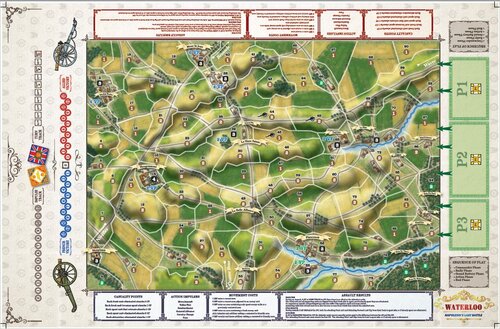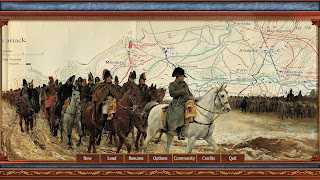Waterloo
Napoleon's Last Battle
by
Companion WarGames
Here we go down the rabbit hole again. There seems to be three battles that every designer wants a crack at: The Bulge, Gettysburg, and Waterloo. I think wargame designers are born with a strange gene that others don't have. It eats at them to design a game based on the above three battles. Of those three battles, I have to say to my mind Waterloo is the most interesting. Gettysburg should historically be won or lost on the first day. The Bulge is pretty much a losing situation for the Germans, unless the designer skews the victory points etc. Waterloo is a totally different animal. Napoleon could very well have won the battle. There are so many 'ifs' involved in it. If Grouchy had actually stopped the Prussians. If Napoleon had attacked with the Guard at 6:30pm. If the ground had not been too soft for cannon fire in the morning. So, we all know that the battle was "the nearest run thing you ever saw in your life" (Duke of Wellington). If he thought it was a close battle, who are we to argue with him. This is designer Mark Scarbrough's attempt at the the big one. let us see what Companion WarGames has put in the box:
Mounted Map 22"x34"
Hard 11"x17" French and English Setup sheets
Hard 11"x17" Prussian Reinforcement Schedule sheet
2 Hard One-Sided Player Aid Cards
1 1/2 Unit Counter Sheets, Large 3/4" Counters
1 Counter Sheet Of Control Markers
I Rulebook
4 Die (2 Red, 2, Blue)
The Mounted Map is normal size for most games. A mounted map causes some gamers to applaud compared to a paper one. I like either kind. You can always use a piece of plexiglass over a paper one. I will admit that mounted maps do hold up better and you will not see the creases in them that you get with an older game you have played a lot. The map itself is divided up into areas. There are no hexes on this map. The way the areas meet each other is meant to show how the battlefield topology was historically. So some movement is not allowed between some of the areas. The map might look a little busy to some because of the color scheme and the areas. I did not have a problem with it. The counters are very large and therefore very easy to read. They are done in bright colors. I like the combination with the map, but again, some may find objection. The only control markers are for the French side. If a marker is not in an area, it is considered to be in Allied control. The counters represent the English, French, and Prussian units. One player plays the French side, and the other plays the Allies (English, Prussian). The Player's Aid Sheets are easy to read and allow you to have a lot of information at your fingertips. The rulebook is thirty-four pages long. The rules themselves take up twenty-six and a half pages. From page twenty-seven there are optional rules that go to page twenty-nine. Pages thirty to thirty-four have examples of play. The Rulebook is in full color, and the print is large. The Rulebook is of paper, so you will get dog ears etc. if you are not careful. The whole presentation of the counters and map to me was excellent. Everything is nice and big, and easy to read and understand. For a first game this is a great effort by Companion WarGames.
This is the Sequence of Play:
• Commander Phase
• Rally Phase
• Grand Battery Phase
• Action Impulse Phase
• End Phase
 |
| Countersheet 1 |
The game has some interesting concepts, besides the area movement. This rule is meant to show the possibility of Napoleon's lethargy during the battle:
6.2 COMMANDER PHASE
Beginning on turn 2, the French player makes DR
during the Commander Phase to determine whether
Napoleon is active or inactive (fresh or spent) for that
turn.
6.2.1 Napoleon Activation. The French player
makes a DR. If it is equal to or greater than
Napoleon’s activation number on the fresh side
of the counter, Napoleon is active for the turn
and begins on his fresh side. If it is less than his
activation number, Napoleon starts the turn on his
spent side.
 |
| Countersheet 3 |
As any game in the 19th century, the rules are heavily dependent on the leaders on both sides. if your leaders are inept, or the subject of frequent bad die rolls good luck to you. Leader Activation works like this: You must roll 2 D6, and you must roll a number equal or higher than the Leader's Activation Rating. Commanders are Activated the same way. Once you have your leader activated you can do these actions:
Move/Assault
Volley Fire
Bombardment
Cavalry Charge
General advance
Commander/Leaders also have Special Actions they can carry out. These are:
Double Move (Commander)
Intervention (Commander)
Die Re-Roll (Leader)
Battle Participation (Leader)
The game has rules for:
Grand Batteries
Skirmishers (A lot of games overlook these)
There are also Optional Rules included, these deal with:
Village Areas
Cavalry Exhaustion (Another overlooked item in games)
Expanded Rally
As I mentioned before with the components, this is an excellent first game from a new company. The game has the feel of Napoleonics about it. It does not give you a feeling that this system would work for any era, like some games do. The leader/commander rules are well thought out and make the player have several contingency plans all at the same time, just in case you do not pass that all important die roll for activation. I want to thank Companion WarGames for allowing me to review this great game. They have four more games in the pipeline:
Seven Days to the Rhine - Cold War goes hot in 1979
Deus Volt - Crusades
Tour of Duty - A Year in Vietnam With the 1st Infantry
Voelkerwanderung - Barbarian Migrations and the Fall of Rome
Robert
Companion WarGames:
Waterloo: Napoleon's Last Battle:
CWG Games — Companion Wargames


























Follow Us